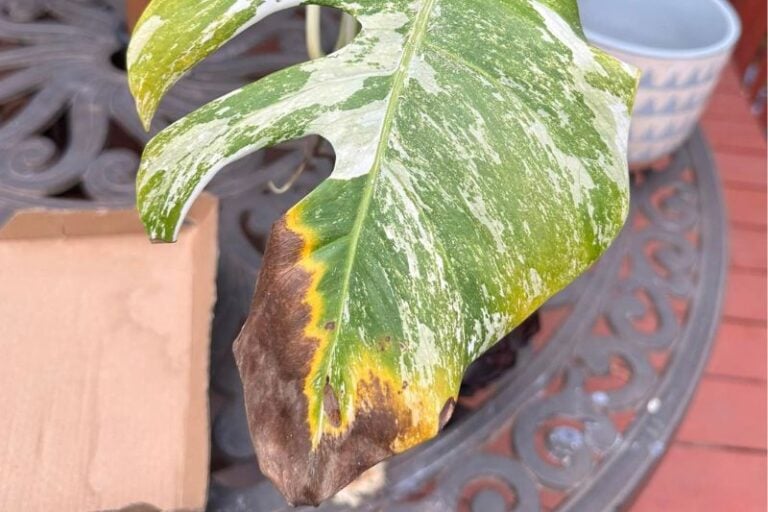There are two types of Monstera: Monstera deliciosa and its variant, Monstera deliciosa var.borsigiana. Monstera deliciosa and Monstera deliciosa var. borsigiana have been the subject of heated discussion among botanists for years.
There is a lot of misunderstanding, so I will clarify some based on my experience with them.
Contents
Are Monstera deliciosa and Monstera deliciosa var. borsigiana the same plant?
To get at the answer to this question, we need to take a brief detour into taxonomy, which is the study of how plants are categorized and given names.
I’ll try to keep this as short and easy to understand as possible. Taxonomy is not that easy, after all.
Here’s how a plant gets its botanical name:
Monstera deliciosa var. borsigiana
Monstera is the common name for the genus of plants known as monstera. This includes all species that could exist.
The species is described as “deliciosa”. Monstera adansonii is another example, it is the same genus as Monstera deliciosa, but it is a different species.
var. borsigiana: The abbreviation “var.” stands for variety. This implies that there is a distinction between “pure” species. This is a distinct growth characteristic.
The var. borsigiana is, therefore, a variety of Monstera deliciosa. The correct, complete name is, therefore, Monstera deliciosa var. borsigiana. It is often called Monstera deliciosa borsigiana, which is incorrect.
So, that only the “pure” Monstera deliciosa is a true Monstera is also incorrect. They both belong to the same plant species, and neither is worse or inferior to the other.
Differences Between Monstera Deliciosa And Monstera Borsigiana
Because Monstera deliciosa var. borsigiana is a variety of Monstera deliciosa, there must be differences, right? Both yes and no.
There are differences in the growth habit, but on the other hand, those differences are not always so obviously visible.
| Monstera deliciosa | Monstera deliciosa var. borsigiana | |
| Leaf size | 2 feet (60-70cm) | 1.5 feet (40-50cm) |
| Leaf shape | oval vertically | round |
| Depth of cut | shallow | deep |
| Notch symmetry | almost target | asymmetric |
| Hole | lots of holes | Fewer holes |
If you look closely, you’ll notice the following differences:
Distinguishing Characteristic 1: Leaf Size And Row of Holes
Monstera deliciosa var. borsigiana is said to have smaller leaves and fewer rows of holes (fenestration) than Monstera deliciosa.
This brings up the first question: when is a leaf big, and when is it small? It’s not very helpful to compare them to plants in the wild because our houseplants never grow to the same size.
The size of the leaf is determined more by its growth or environmental conditions than by its variety.
If the plant receives a lot of light, the surrounding air is sufficiently humid, and your Monstera climbs up a trellis, the leaves will grow in size.
Distinguishing Characteristic 2: Ruffles At The Transition From Petiole To Leaf
Only the “pure” Monstera deliciosa should have ruffles or small waves ( at the transition from petiole to leaf.
This characteristic also depends on the size of the plant. Whether they are var. borsigiana or not, the young plants won’t have any ruffles.
This is because they only show up when the leaves are really big. Moreover, even then, their visibility is not guaranteed.
However, ruffles can be found on both Monstera deliciosa and Monstera deliciosa var. borsigiana.
Distinguishing Characteristic 3: The Distance Between Nodes
The only distinguishing feature between Monstera deliciosa and var. borsigiana is the distance between the individual nodes (these are the slightly thicker areas from which the leaves grow).
“More or less” because even this characteristic can be influenced by the environment in which your Monstera grows.
Monstera deliciosa var. borsigiana has a more elongated growth habit. This indicates that the internodes, or distances between individual nodes, are relatively large. As a result, there is a visible piece of stem between the individual leaves.
In contrast, “pure” Monstera deliciosa grows more compactly or stockily. The internodes are barely visible, if at all.
They are rarely wider than an inch, and the leaves are very close together. Deliciosa has a clogged stem that looks like a shrimp, while Borsigiana grows longer.
Because of the short distances between the nodes, the ‘pure’ Monstera deliciosa prefers to creep rather than climb.
If you provide ideal growing conditions for your Monstera deliciosa var. borsigiana, the distance between individual nodes on new leaves will decrease over time. However, this may take some time.
Where Can I Find “Pure” Monstera Deliciosa?
Unfortunately, I must disappoint you. It is difficult to find “pure” Monstera deliciosa.
Because of all the crossings, it’s not always easy to tell if it’s a “pure” Deliciosa. You’ll find something sooner or later if you have patience and a diligent search.
Hopefully, I can put your mind at ease: Monstera deliciosa and var. borsigiana have the same lovely leaves. These are the reasons why we adore Monstera.












